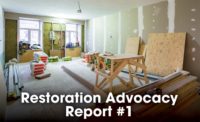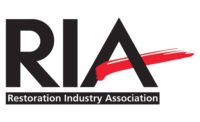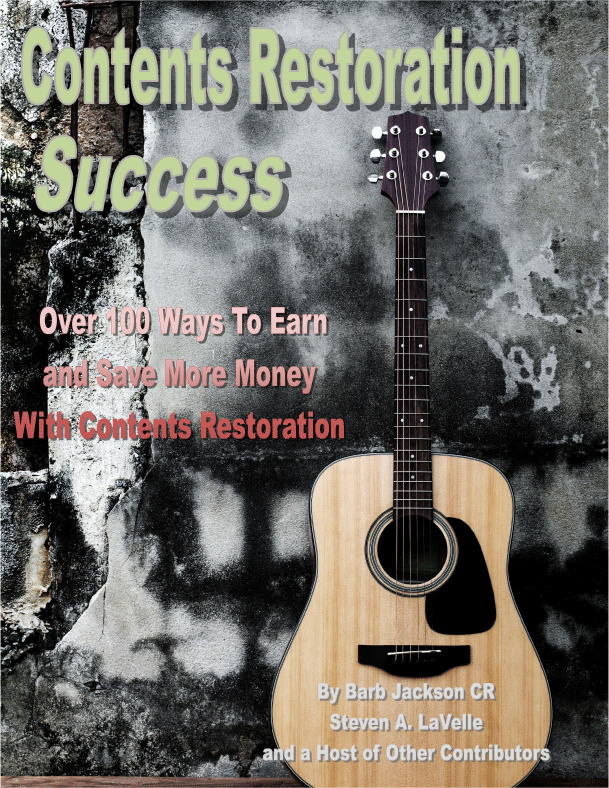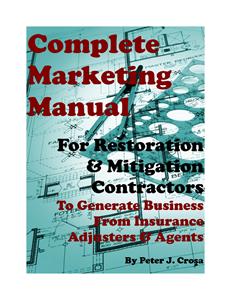Web Exclusive
Restoration Advocacy Report #2

The Restoration Industry Association (RIA) is stronger than it has been in decades and now, it is leading the charge to transform the industry as its Chief Advocate on the front lines. This is the second in an ongoing series of official Reports from its Advocacy and Government Affairs (AGA) Committee. The mission of the AGA is to develop and implement strategies to help create and maintain a fair and level playing field, financially and legally, for restoration contractors, by advocating for their interests, while working collaboratively with stakeholders involved in the restoration process.
THE BLUEPRINT FOR THE AGA
The leadership of the RIA is not satisfied with the status quo. It is hungry for change and it is acting on that hunger. Stimulated by youthful governance and fresh ideas, the Restoration Industry Association (RIA) has made a bold public commitment to effect real change that will positively impact restorers’ businesses in a measurable way. RIA President-Elect, Mark Springer, CR, of Dayspring Restoration in Montana, wrote a groundbreaking article entitled Our Greatest Need, published in the 2019 first quarter edition of Cleaning & Restoration Magazine. (See here.) He made the case for and outlined a path to, advocacy for the restoration industry. He wrote of many problems very familiar to restorers, including issues with standardized pricing platforms, TPAs, claims consultants and government regulation. The article garnered widespread attention and support, because it included a specific, action-oriented seven-step blueprint to address the problems:
- Step 1: Create an Advocacy and Government Affairs (AGA) Committee;
- Step 2: Prioritize Issues and Get Member Feedback;
- Step 3: Develop Position Papers and Position Statements;
- Step 4: Hire A Restoration Advocate;
- Step 5: Monitor Issues, Advocate for Positions and Build Coalitions;
- Step 6: Inform and Engage Membership;
- Step 7: Hire One or More Restoration Lobbyists
In Report #1, we submitted that it is time for restorers to unite before irreversible damage is done, quoting General George S. Patton, Jr. who said: “A good plan, violently executed now, is better than a perfect plan executed next week.” We are pleased to announce that in nine short weeks, the RIA completed the first two steps and made great progress on steps 3, 5 and 6.
STEP 1: CREATE AN ADVOCACY COMMITTEE. STATUS: DONE.
On May 1, 2019, the RIA rolled out its Advocacy and Government Affairs (AGA) Committee at the Town Hall meeting during its annual convention in Phoenix. I have been honored with the position of Chairman of the Committee, which consists of an array of talented and extremely successful restoration practitioners with diverse skill sets: Todd Benson of Oakwood Construction & Restoration Services, Inc. (a BELFOR company), Steven Anderson of Anderson Group International, Will Akin of McKenzie/Taylor Construction, Dave Robbins of SRP Contractors, LLC, Tom Peter of Insurance Restoration Specialists, Jeff Gross of Maxons Restoration, Inc., Charles Cassani of Restoration Management Company and Katie Smith of PHC Restoration. Each of them has very strong business acumen, runs a successful business and contributes fresh ideas, not only to tackle the problems of today but to anticipate the problems of tomorrow.
The RIA is the oldest and largest restoration industry trade association. At the ripe old age of 73, it has proven its resilience and now, it has been revitalized by progressive and enthusiastic leaders. I submit that it is clearly the best-suited entity to represent the industry on critical issues. RIA is in growth mode and is adapting to changing conditions in the marketplace to better serve its members. RIA has re-branded its annual convention as the International Restoration Industry Expo which everyone should attend in New Orleans from April 14 to April 16, 2020. The RIA thought long and hard about the fact that the biggest event in this industry is a TPA conference. RIA’s 2020 convention will be co-located with DKI for the mutual benefit of the two organizations and the industry as a whole. This is part of the coalition building, discussed under Step 5, below.
The AGA effort cannot succeed without significant financial investments for experts, research and other expenses, so the AGA formed a Fundraising Subcommittee. We are blessed to have industry sage Warner Cruz of J.C. Restoration in Bensenville, IL as Chairman of that Subcommittee.
The goal of AGA is to raise $100,000 in its first 90 days and as of July 4, 2019, $58,985 has been pledged and $50,460 has been collected. Mr. Cruz has vowed to support the effort in any way he can to bring unity to restoration contractors, noting that his father had always told him this was something that needed to be done in the industry. He is excited that the industry has finally coalesced in a way that will allow the voices of restorers large and small to finally be heard. Mr. Cruz’s success story and his passion for AGA is featured here on the RIA Content Hub.
STEP 2: PRIORITIZE ISSUES AND GET MEMBER FEEDBACK. STATUS: DONE.
RIA polled members at its annual convention and received a lot of member feedback, explained in more detail under Step 6, below. Many attendees submitted Commitment Cards and made important comments about our direction. The AGA has now received and sorted feedback from hundreds of restorers about the issues that plague their businesses. The Committee and Subcommittees give us a close feel for the heartbeat of our members. After careful review, it became clear that two biggest priorities are pricing and interference from third parties, such as TPAs and independent building consultants. The AGA hears you and is taking action. See Steps 3 and 5.
STEP 3: DEVELOP POSITION PAPERS AND POSITION STATEMENTS. STATUS: IN PROGRESS.
The AGA will thoughtfully evaluate issues and publish and disseminate white papers taking definitive positions intended to ensure that restorers are treated fairly, stop the downward spiral and help restorers sustain long term financial and operational health. Restorers, large and small, will be able to hang their hats on those positions and will know they are in good company sticking to their guns on those issues. Our hope is that the industry will finally band together through this effort.
On the TPA front, the AGA is working actively with RIA’s TPA Task Force, chaired by Ben Looper of Southeast Restoration. Among other things, his team is drafting a position paper about TPA requests for changes in scope that are not outlined in program agreements. Great care will be used in the creation of all RIA position papers and they will be vetted and scrutinized before they are published. This is a time-consuming process, but will be worth the wait.
STEP 4: HIRE A RESTORATION ADVOCATE. STATUS: PENDING YOUR INVESTMENT.
Once the industry has made the requisite financial commitment in this movement, the AGA will hire a Restoration Advocate. Rather than a volunteer speaking for RIA in his or her spare time, the Restoration Advocate will be a paid professional with a detailed scope of work and specific goals. To avoid conflicts of interest and fears of retaliation, the right candidate for this position will not be currently engaged in the business of restoring property, but will have deep understanding of the industry and its history, a strong reputation and credibility and the ability to communicate effectively with the myriad of stakeholders who affect the outcome of a restoration project. As Mark Springer stated so deftly in Our Greatest Need¸ the Advocate must be a tough-as-nails diplomat, not an administrative wallflower or policy wonk. The Advocate will report to me and the RIA Executive Director. We stand ready to vet candidates for this position. This unique individual may not be easy to find, so please put the word out and send confidential nominations for this position to EdCross@EdCross.com. Once the funds are available and the Executive Committee and the AGA approve the nomination, you will see results from Step 4.
STEP 5: MONITOR ISSUES, ADVOCATE FOR POSITIONS AND BUILD COALITIONS. STATUS: PENDING YOUR INVESTMENT.
Large volumes of information are now flowing rapidly to the AGA headquarters through dozens of industry conduits (and to EdCross@EdCross.com) and we are very grateful to everyone who helps keep us informed in real time of the real challenges happening in the field. As the AGA grows, more subcommittees will be formed and they will provide ammunition necessary for the Advocate to be effective.
Xactware presented at the annual convention and some of what I heard varied greatly from what my restoration contractor clients have been telling me over the years. However, in my experience as a litigator and mediator, I often find that truth is somewhere in the middle between what the two sides are saying, so I sent a letter to Greg Pyne, Vice President of Pricing at Xactware, requesting a meeting with me to get to the bottom of these problems. He cordially agreed and although we have not raised funds necessary to engage the Advocate, we are in the process of preparing for that meeting. To make sure I am properly prepared for that meeting and to pursue one of the main goals of the AGA, which is fairness in pricing, we formed a Pricing Subcommittee. I am delighted to report that the phenomenal Dave Robbins is the Chairman of that Subcommittee.
The highly energetic Mr. Robbins immediately took the proverbial ball and ran with it, forming a very powerful Subcommittee of some of the best and brightest restoration pricing experts in the country. His phenomenal group is conducting in-depth research and gathering data for my upcoming meeting with Mr. Pyne. We don’t have all the solutions yet, but one thing is clear: things have to change. We hope that the meeting will not be a singular event but rather the commencement of ongoing dialogue between the two organizations that will lead to some reasonable solutions. Please watch for future Advocacy Reports for updates.
The RIA and AGA have already made great strides at building coalitions and alliances and this work will continue. We will partner with any entity that agrees with our vision, vows to pursue our mission and would like to unite with us. In addition to rolling out the AGA at the annual convention, RIA and the Institute of Inspection Cleaning and Restoration Certification (IICRC) executed a “Mutual Benefit Agreement” in a live signing ceremony. The Agreement memorializes a strong alliance whereby the two industry giants will work together to establish areas of mutual interest that will include advocacy for restorers. This is one of many coalitions that will expand the reach of RIA, making it more powerful, more efficient and more effective. We are also seeking to collaborate with other associations where we have mutual benefit, such as the Indoor Air Quality Association and its Government Affairs Committee. More important alliances are in the works and will be announced in the coming weeks and months.
STEP 6: INFORM AND ENGAGE MEMBERSHIP. STATUS: IN PROGRESS.
This step is a process––not an event––and therefore, it will never be “done.”
In the days before the annual convention, RIA made the shrewd decision to move the Town Hall meeting from its traditional place at the end of the convention—to the #1 position at very beginning of the convention. This was a strong public statement that RIA sees advocacy as its #1 task.
What followed was a big, bold information and engagement campaign, in every conceivable medium. The outreach is too vast to fully describe here and this Report only includes a few representative highlights. The AGA distributed Commitment Cards at the Town Hall, which secured investments of time and/or money from a large group of enthusiastic restorers. Immediately after the convention, a social media frenzy began with restorers large and small, everywhere from rural areas to major metropolitan markets, distributing Commitment Cards and directing the attention of their peers to the RIA as the entity best suited and best equipped to advocate for the business interests of restoration contractors. Many of the recipients of this message had never heard of RIA before the AGA was formed and might never have heard of it had it never been formed. Investments continue to flow in from restorers who want to fuel this movement.
RIA implemented cutting edge technology at the Town Hall which allowed attendees to ask questions through their smart devices. The level of interest was beyond what we had anticipated and the number of questions was too large to answer in the time allotted for the Town Hall, so RIA promised to address those questions in a follow-up webinar. If fulfilled that promise on June 27, 2019 in a webinar hosted by Mark Springer and sponsored by IICRC and Sunbelt. The webinar can be viewed here.
Everyone who invested $150 or more in the AGA received a free pass to a Pricing Feedback Webinar by restoration pricing expert Ben Justesen of JRCC and Enlightened Restoration Solutions. The webinar covers methods a contractor can use to determine his or her own pricing, make price lists and how to submit pricing feedback to Xactware. Mr. Justesen has successfully increased his retail labor rates using the XactAnalysis feedback tool and shares that process in his Webinars. Once you effectively change the Retail Labor Rates, Xactimate automatically increases local unit pricing. Mr. Justesen has successfully increased his retail labor rates using the XactAnalysis feedback tool. He also created the Labor Calculator which is available for free on the RIA Web site.
RIA Executive Committee and AGA Committee member, Katie Smith wrote an outstanding story about the Town Hall meeting which can be seen here. She also gave a compelling and very well-received presentation about the need for the advocacy and the vision of the AGA at the Violand Executive Summit in Canton, Ohio in June.
With the birth of the AGA, RIA has new, bigger social media presence, with intensive coverage on Facebook, LinkedIn, the RIA web site www.restorationindustry.org, Cleaning & Restoration Magazine, Restoration & Remediation Magazine and Cleanfax. The AGA is collaborating with many major entities in the restoration sphere to build a broad coalition in the industry. The Committee is keeping the industry abreast of its activities and all major developments. Accordingly, these Advocacy Reports will be consistently published in several leading restoration trade publications. Between reports, there will be updates on the RIA Content Hub at https://cr.restorationindustry.org (which is a treasure trove of valuable research and writing on issues of great importance to restorers). The AGA extends its special thanks to the multitude of media outlets and supporters who have helped to spread the word and allowed the AGA to gain rapid momentum in a short period of time.
STEP 7: HIRE RESTORATION LOBBYISTS: STATUS: PENDING YOUR INVESTMENT.
The AGA is actively carving a pathway to become involved in lobbying activities to help the restorer, something it never did before the AGA was born. With enough support from you, the AGA will provide advocacy for restoration professionals across the country and seek to influence legislation and/or reform as needed, on a priority basis.
JOIN THE MOVEMENT
From day one, AGA started a powerful grassroots movement with the support and public support of conscientious restorers who want to get involved and make a difference. In the 22 years I have had the pleasure of working for the restoration industry, I have never seen or heard of an industry initiative that has sparked so much enthusiasm and so much unity. Won’t you please join us? If you have not already done so, please download your Commitment Card here and email it to me today at EdCross@EdCross.com.

As for the money, Contractors have suggested the very modest investment of 1/100th of one percent of each restoration company’s annual gross revenue, i.e., $100 per one million in gross revenue. My personal investment will be much more than that and I know that many contractors will be inspired and willing to invest considerably more.
Each member of the AGA Committee has pledged to make an investment of at least 1/100th of 1% because they know the investment will pay off if the industry unites and they believe the RIA is in the best position to effect this change. Please join them by sending a check to the RIA at 330 N Wabash Ave., Suite 2000, Chicago, IL 60611. Please make your check payable to “AGA.” The AGA will continually remind the investors and members at large of the benefits produced by their investments. Investments are what drives progress, no matter how little or how big that investment may be.
Please support the AGA now. This will be labor-intensive, so we need people, ideas and money.
- We need people to perform research, write papers and serve on subcommittees and task forces.
- Please volunteer to help on whatever level you can and please submit ideas for issues that warrant examination by the Committee, by emailing me at EdCross@EdCross.com or by calling the AGA Headquarters at (760) 773-4002. Please write “AGA” in the subject line of your emails. We will carefully consider all ideas submitted, using a triage system.
I wish to extend special thanks to industry veteran AGA member Charles Cassani, for his valuable contributions to this Report.
Many hands make light work and pulling together, we will make a difference.
Thank you, once again, for the opportunity to serve the restoration industry.

Edward H. Cross, Esq., Chairman
Looking for a reprint of this article?
From high-res PDFs to custom plaques, order your copy today!








